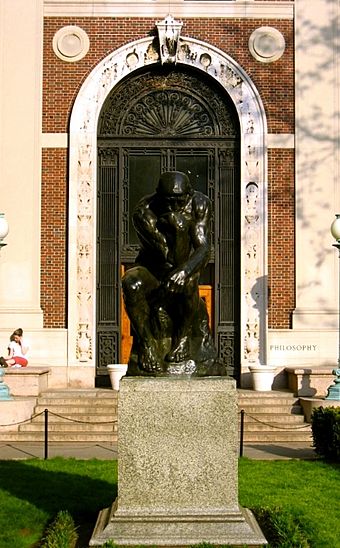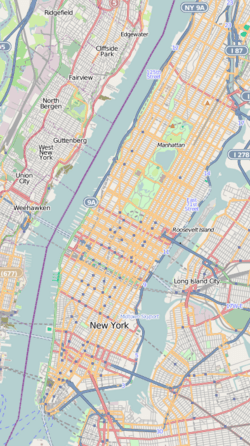Philosophy Hall facts for kids
|
Philosophy Hall
|
|

Rodin's The Thinker with Philosophy Hall in the background
|
|
| Location | 1150 Amsterdam Avenue, Columbia University |
|---|---|
| Nearest city | New York City |
| Built | 1910 |
| Architect | McKim, Mead and White |
| Architectural style | Italian Renaissance Revival |
| NRHP reference No. | 03001046 |
Quick facts for kids Significant dates |
|
| Added to NRHP | July 31, 2003 |
| Designated NHL | July 31, 2003 |
Philosophy Hall is an important building at Columbia University in New York City. It is home to several departments, like English, Philosophy, and French. You can also find the university's writing center here. Part of the registrar's office and a student lounge are also in this building.
This hall was one of the first buildings designed for Columbia University's Morningside Heights campus. It was built in a beautiful style called Italian Renaissance Revival. The building was finished in 1910. Philosophy Hall is listed on the National Register of Historic Places. It is also a National Historic Landmark. This means it's a very special place in American history. It earned this title because Edwin Armstrong invented FM radio here in the early 1930s.
Contents
A Place of Great Discoveries
The area where the registrar's office is now used to be a laboratory. Here, scientists like Michael I. Pupin and Edwin Howard Armstrong made huge breakthroughs. These discoveries changed technology forever. Armstrong's invention of FM radio was especially important. It made radio sound much clearer.
Famous Minds at Philosophy Hall
Many famous professors have worked in Philosophy Hall. These include important thinkers like John Dewey and Ernest Nagel. The building was also home to the Guadeloupean novelist Maryse Condé. Poets like Kenneth Koch and literary scholars like Lionel Trilling also taught here. These brilliant people helped shape many students' minds.
A Unique Campus Building
Philosophy Hall is one of the few buildings at Columbia University named after a subject. Most other buildings are named after people. Other buildings named after subjects include Mathematics, Journalism, and International Affairs. This makes Philosophy Hall stand out.
The Thinker Statue
Right in front of Philosophy Hall, you can see a famous statue. It is an original cast of The Thinker (Le Penseur). This well-known sculpture was created by the French artist Auguste Rodin. It shows a person deep in thought.
A Refuge During Protests
In 1968, there were big student protests at Columbia University. Many buildings were occupied by students. However, Philosophy Hall was not taken over by protesters. Instead, it became a safe place for professors. They used the hall to have important discussions about the student protests.
Images for kids





